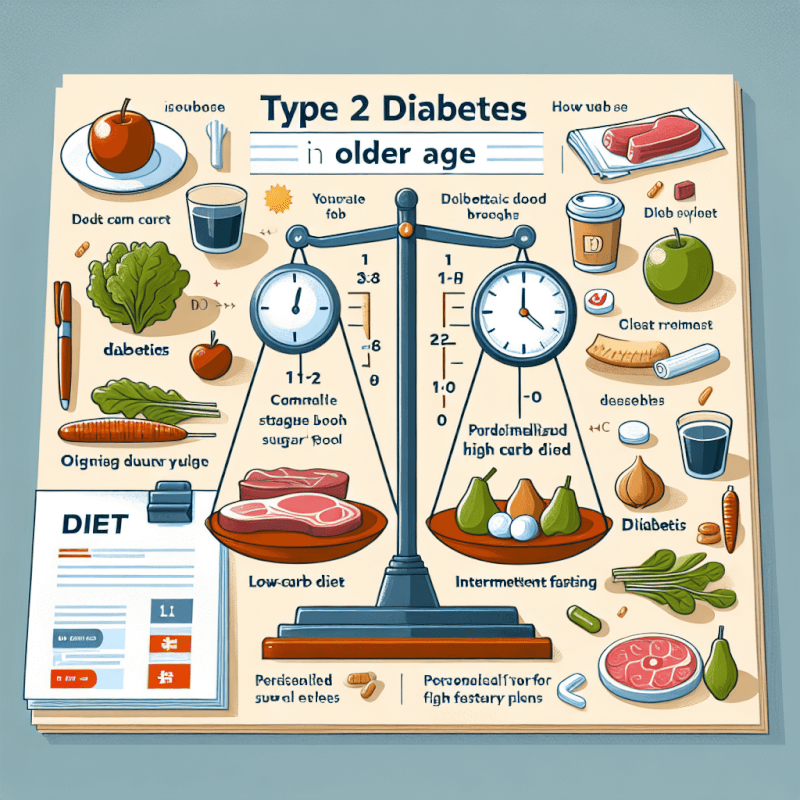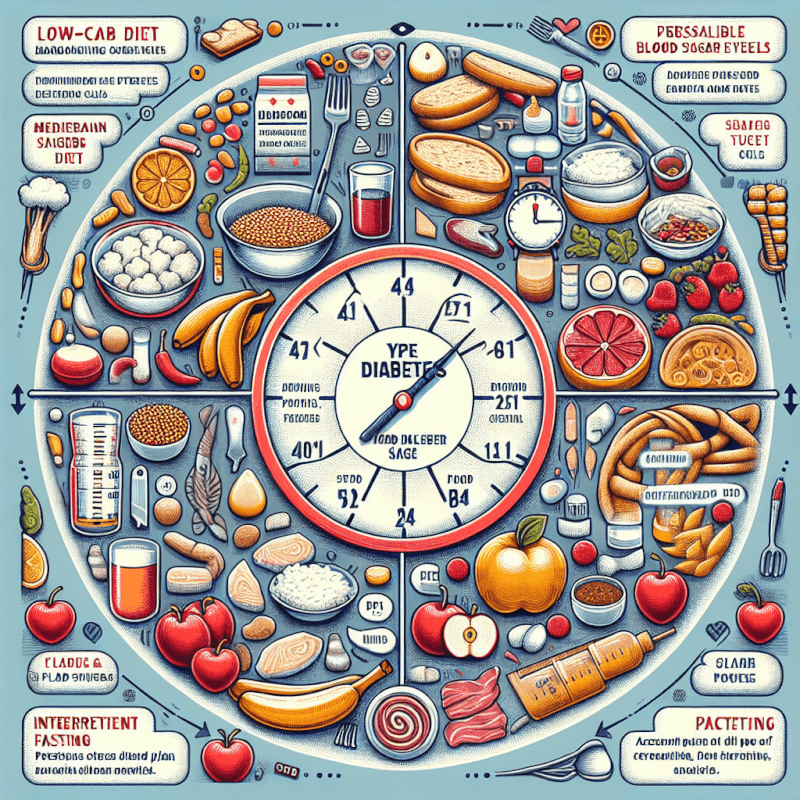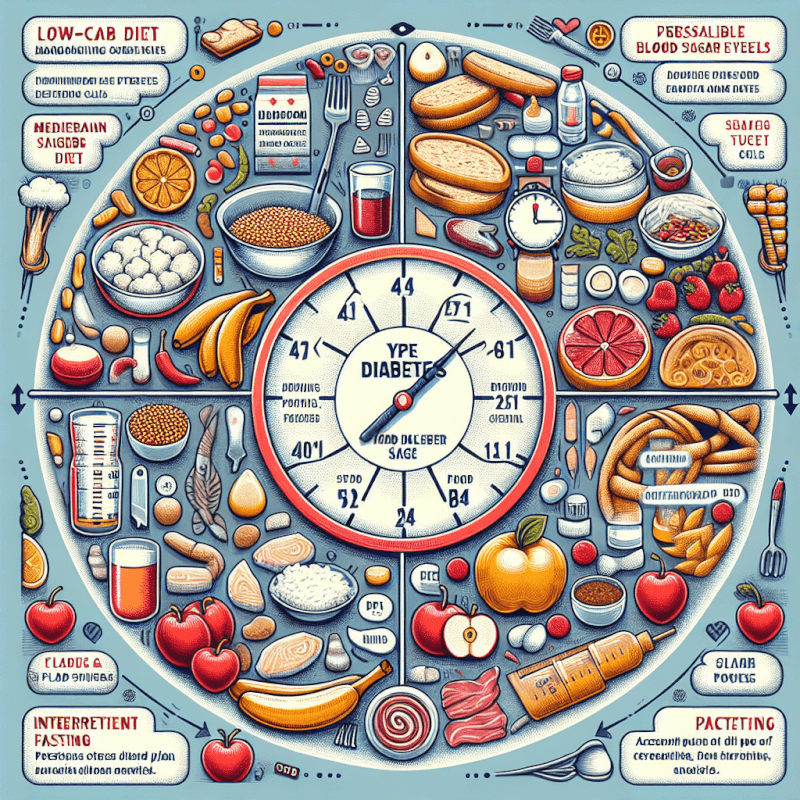Managing type 2 diabetes can be challenging, especially as we age. With a plethora of dietary options available, it can be overwhelming to determine which approach is truly the best for managing this condition. In this article, we will explore the various dietary approaches that have been proven effective for managing type 2 diabetes in older age. By understanding the role of nutrition in diabetes management and the specific dietary strategies that can help control blood sugar levels, you will be equipped with the knowledge needed to make informed decisions about your diet and live a healthier, more fulfilling life.

Low-carbohydrate Diet
Definition and Principles
A low-carbohydrate diet is a dietary approach that focuses on reducing the intake of carbohydrates, primarily from sources such as bread, pasta, rice, and sugary foods. Instead, it emphasizes consuming foods that are rich in protein and healthy fats. By limiting carbohydrate intake, the body’s blood sugar levels are stabilized, which can be particularly beneficial for older adults with type 2 diabetes.
Benefits for Older Adults
For older adults with type 2 diabetes, following a low-carbohydrate diet can offer several benefits. Firstly, it can help improve blood sugar control by minimizing the amount of glucose entering the bloodstream. This can lead to better management of diabetes symptoms and reduce the risk of complications associated with the condition.
Additionally, a low-carbohydrate diet may aid in weight management, as it often promotes increased satiety and reduced calorie intake. Maintaining a healthy weight is crucial for older individuals as it can help prevent or manage other chronic conditions often associated with aging, such as cardiovascular disease and hypertension.
Furthermore, studies have shown that a low-carbohydrate diet can improve insulin sensitivity in older adults, making their bodies more responsive to insulin and better able to regulate blood sugar levels. This can have long-term benefits in managing type 2 diabetes and minimizing the need for medication.
Effectiveness for Managing Type 2 Diabetes
The effectiveness of a low-carbohydrate diet in managing type 2 diabetes has been widely studied, and the results have been promising. Research has shown that reducing carbohydrate intake can lead to improved glycemic control, fasting glucose levels, and insulin resistance in older adults with diabetes.
A study published in the Annals of Internal Medicine found that participants who followed a low-carbohydrate diet experienced greater reductions in hemoglobin A1c levels (a measure of long-term blood sugar control) compared to those on a low-fat diet. This suggests that a low-carbohydrate diet can be an effective dietary approach for managing type 2 diabetes in older age.
However, it is important to note that while a low-carbohydrate diet can be beneficial for some individuals, it may not be suitable for everyone. It is always recommended to consult with a healthcare professional before making significant changes to your diet, especially if you have any underlying health conditions or are taking medication.
Mediterranean Diet
Overview of the Diet
The Mediterranean diet is a dietary pattern inspired by the traditional eating habits of people in countries bordering the Mediterranean Sea. It is characterized by an emphasis on fruits, vegetables, whole grains, legumes, fish, and olive oil. This diet is low in red meat, saturated fats, and processed foods, making it a healthy and balanced approach to nutrition.
Advantages for Older Individuals
The Mediterranean diet has numerous advantages for older individuals, including those with type 2 diabetes. Its emphasis on whole, nutrient-dense foods provides a wide array of vitamins, minerals, and antioxidants that support overall health and well-being.
This diet is rich in fiber, which aids in digestion and helps regulate blood sugar levels. It also promotes heart health by reducing the risk of cardiovascular disease, a common comorbidity in older adults with diabetes. The inclusion of healthy fats, such as those found in olive oil and fatty fish, can help lower inflammation and improve insulin sensitivity.
Furthermore, the Mediterranean diet is associated with cognitive benefits, which can be particularly important in older age. Some studies have suggested that this dietary pattern may reduce the risk of cognitive decline and improve memory and cognitive function in older adults.
Impact on Type 2 Diabetes Control
Numerous studies have shown that following a Mediterranean diet can have a positive impact on the management of type 2 diabetes in older individuals. This diet’s emphasis on low-glycemic index foods and complex carbohydrates helps regulate blood sugar levels and prevents rapid spikes and crashes.
Research published in the journal Diabetes Care found that older adults with diabetes who followed a Mediterranean diet experienced better glycemic control and reduced cardiovascular risk factors compared to those following a low-fat diet. It also resulted in improved insulin sensitivity and lower inflammatory markers, further supporting the management of type 2 diabetes.
Overall, the Mediterranean diet offers a well-rounded approach to nutrition for older adults with type 2 diabetes, providing numerous health benefits beyond blood sugar control.
Plant-Based Diets
Different Types of Plant-Based Diets
Plant-based diets encompass a range of dietary patterns that prioritize the consumption of plant-derived foods while minimizing or eliminating the intake of animal products. Some variations include vegetarian, vegan, and flexitarian diets.
A vegetarian diet eliminates meat but may include animal-derived products such as dairy and eggs. A vegan diet excludes all animal products, including dairy and eggs. Finally, a flexitarian diet is primarily plant-based but allows for occasional consumption of animal products in moderation.
Pros for older Age Group
Plant-based diets offer several advantages for older individuals, including those with type 2 diabetes. Firstly, they are typically high in fiber, which can aid in digestion, promote satiety, and help manage blood sugar levels. This is especially important for individuals with diabetes, as fiber slows down the absorption of glucose, preventing sharp blood sugar spikes.
Additionally, plant-based diets are generally lower in saturated fats and cholesterol, which can be beneficial for heart health. Older adults are at a higher risk of cardiovascular disease, and adopting a plant-based diet can help mitigate this risk.
Plant-based diets rich in fruits, vegetables, legumes, and whole grains are also abundant in vitamins, minerals, and antioxidants. These nutrients support overall health, strengthen the immune system, and reduce inflammation – factors that can contribute to better management of type 2 diabetes and improved overall well-being.
Role in Managing Type 2 Diabetes
Numerous studies have investigated the role of plant-based diets in managing type 2 diabetes, particularly in the older population. Research published in the Journal of Geriatric Cardiology found that plant-based diets were associated with improved glycemic control, body weight, and lipid profiles in older individuals with diabetes.
Adopting a plant-based diet has also been shown to reduce the risk of developing type 2 diabetes. A study published in the Journal of Diabetes Investigation found that individuals following a vegetarian or vegan diet had a lower risk of developing type 2 diabetes compared to those consuming a non-vegetarian diet.
Overall, incorporating plant-based foods into the diet can contribute to better management of type 2 diabetes in older age. However, it is important to ensure that nutritional needs are met, particularly in terms of protein, vitamin B12, iron, and omega-3 fatty acids, which are commonly found in animal products. Consulting a healthcare professional or registered dietitian can help ensure a healthy and balanced plant-based diet suitable for older individuals with type 2 diabetes.
DASH Diet
Introduction to DASH
The Dietary Approaches to Stop Hypertension (DASH) diet is a dietary approach specifically designed to lower blood pressure and prevent hypertension. However, it offers additional benefits for older individuals, particularly those with type 2 diabetes.
The DASH diet emphasizes consuming fruits, vegetables, whole grains, lean proteins, and low-fat dairy products while limiting sodium, saturated fats, and sweets. It is a well-rounded and balanced eating plan that can promote overall health and prevent chronic conditions.
Applicability for Older Individuals
The DASH diet is highly applicable for older individuals, as it aligns with the nutritional needs and health concerns commonly faced in this age group. Its focus on whole, unprocessed foods ensures adequate intake of essential vitamins, minerals, and antioxidants necessary for maintaining optimal health.
For older adults with type 2 diabetes, the DASH diet can be particularly beneficial. Its emphasis on low-sodium foods can help manage high blood pressure, which often accompanies diabetes in older age. Moreover, reducing sodium intake can improve insulin sensitivity and contribute to better blood sugar control.
The DASH diet’s inclusion of lean proteins, whole grains, and healthy fats provides a well-rounded nutritional profile, helping to maintain muscle mass, support bone health, and prevent age-related nutrient deficiencies.
Benefits for Type 2 Diabetes Control
Studies have shown that the DASH diet can have positive effects on managing type 2 diabetes in older adults. Research published in the Journal of the American College of Nutrition found that following the DASH diet was associated with improved glycemic control and reduced insulin resistance in adults with type 2 diabetes.
The diet’s emphasis on whole grains, fruits, and vegetables rich in fiber can help regulate blood sugar levels and prevent sudden spikes or crashes. Additionally, its focus on low-fat dairy products can provide essential nutrients such as calcium and vitamin D, which are crucial for bone health.
However, it is important to note that individual responses to the DASH diet may vary. Consulting a healthcare professional or registered dietitian can help tailor the diet to personal needs, preferences, and any specific considerations related to type 2 diabetes management.

Portion Control
Understanding Portion Control
Portion control refers to the practice of monitoring and moderating the amounts of food consumed in each meal or snack. It involves being mindful of portion sizes and listening to your body’s hunger and fullness cues.
In older age, portion control becomes increasingly important as metabolism slows down and nutrient needs may change. With type 2 diabetes, it is crucial to manage carbohydrate intake to maintain stable blood sugar levels.
Relevance to Older Age
As individuals get older, their energy needs often decrease due to a decrease in physical activity and changes in body composition. This makes it essential to adjust portion sizes accordingly to prevent overeating and weight gain.
Portion control also helps maintain a healthy weight, which is crucial for managing type 2 diabetes and reducing the risk of related complications. Overconsumption of calories, especially from carbohydrates, can lead to elevated blood sugar levels and increased insulin resistance.
Furthermore, portion control can prevent excessive calorie intake from fats and proteins, as well as excess sodium intake. These factors can contribute to conditions such as hypertension and cardiovascular disease, which are common in older adults with diabetes.
Impact on Type 2 Diabetes Management
Practicing portion control can have a significant impact on the management of type 2 diabetes in older age. By moderating carbohydrate intake and distributing it evenly throughout the day, blood sugar levels can be better controlled.
Carefully monitoring portion sizes can prevent blood sugar spikes and help maintain stable glucose levels, reducing the need for additional medication or insulin. It allows older adults with diabetes to better balance their meals and prevent excessive carbohydrate intake in one sitting.
Portion control can also aid in weight management, as it helps control overall calorie intake. Maintaining a healthy weight is crucial for managing type 2 diabetes effectively and preventing complications associated with obesity, such as cardiovascular disease and joint problems.
Adopting portion control practices, such as using smaller plates, measuring food portions, and eating mindfully, can contribute to better management of type 2 diabetes in older adults and support overall health and well-being.
Glycemic Index
Definition and Concept
The glycemic index (GI) is a measurement used to evaluate how quickly and to what extent different carbohydrate-containing foods raise blood sugar levels. It ranks foods on a scale of 0 to 100, with higher values indicating a more rapid increase in blood glucose levels.
Foods with a high GI are rapidly digested and absorbed, causing a sharp increase in blood sugar levels. On the other hand, foods with a low GI are digested and absorbed more slowly, resulting in a slower and more controlled rise in blood glucose.
Significance in Older Adults
The glycemic index is particularly significant for older adults as it can help manage blood sugar levels and prevent sudden spikes or crashes. Maintaining stable blood sugar levels is critical in managing type 2 diabetes, as it can prevent symptoms and minimize the risk of complications.
Older adults may also be more susceptible to insulin resistance, making it essential to choose carbohydrates with a lower GI to avoid overburdening the body’s insulin response. Additionally, fluctuations in blood sugar levels can negatively affect energy levels, mood, and cognitive function, highlighting the importance of stable glycemic control in older age.
Effectiveness for Type 2 Diabetes
The glycemic index has proven to be an effective tool in managing type 2 diabetes, particularly in older adults. By selecting foods with a lower GI, individuals can regulate blood sugar levels more precisely and avoid sudden spikes or drops.
Research published in JAMA Internal Medicine demonstrated that following a low GI diet for six months resulted in better glycemic control and reduced HbA1c levels in individuals with type 2 diabetes. This highlights the potential benefits of incorporating low GI foods into the diet and the impact it can have on managing diabetes symptoms.
Moreover, consuming low GI foods can promote satiety and help with weight management, which is crucial for older adults with type 2 diabetes. By avoiding high GI foods that can lead to overeating and weight gain, individuals can support their overall health and maintain stable blood sugar levels.
Incorporating low GI foods into the diet, such as whole grains, legumes, and non-starchy vegetables, can contribute to better management of type 2 diabetes in older adults. However, it is important to consider individual dietary needs and preferences when incorporating the glycemic index into a diabetes management plan.

Dietary Fiber
Overview of Dietary Fiber
Dietary fiber refers to the indigestible parts of plant-based foods. It includes various forms, such as soluble and insoluble fiber, and is found in foods such as fruits, vegetables, whole grains, legumes, and nuts.
Fiber is beneficial for overall health, as it aids in digestion, promotes satiety, and supports a healthy gut microbiome. It is particularly relevant for older individuals, including those with type 2 diabetes, due to its impact on blood sugar management and other health benefits.
Importance for Older Individuals
Dietary fiber holds significant importance for older individuals, as it addresses several age-related health concerns. Firstly, it supports digestive health by promoting regular bowel movements and preventing constipation, a common issue in older adults.
Additionally, fiber-rich foods tend to be less energy-dense and promote satiety, which can aid in weight management and prevent overeating. Maintaining a healthy weight is crucial for managing type 2 diabetes effectively and reducing the risk of complications.
Adequate fiber intake is also associated with a reduced risk of cardiovascular disease, a common comorbidity in older adults with type 2 diabetes. It helps lower cholesterol levels and supports heart health by enhancing blood lipid profiles.
Role in Controlling Type 2 Diabetes
Dietary fiber plays a crucial role in controlling type 2 diabetes, as it influences blood sugar management and insulin sensitivity. Fiber slows down the absorption of glucose, preventing sudden blood sugar spikes and promoting more stable levels.
Soluble fiber, in particular, forms a gel-like substance in the digestive tract, which can slow the absorption of glucose and improve insulin sensitivity. This can lead to better control of blood sugar levels and reduced insulin resistance, key factors in managing type 2 diabetes.
Research published in the journal Diabetologia demonstrated that higher dietary fiber intake was associated with improved glycemic control and reduced risk of developing type 2 diabetes in older individuals.
Including fiber-rich foods in the diet, such as fruits, vegetables, whole grains, legumes, and nuts, can contribute to better management of type 2 diabetes in older age. However, it is essential to increase fiber intake gradually, drink plenty of water, and consider individual dietary preferences and any underlying digestive issues.
Protein Intake
Protein Requirements in Older Age
Protein is essential for maintaining and repairing body tissues, supporting immune function, and promoting overall health. In older age, it becomes increasingly important to ensure adequate protein intake, as the body’s ability to utilize and absorb protein may decline.
The Recommended Dietary Allowance (RDA) for protein in older adults is higher than in younger adults, primarily to compensate for age-related muscle loss and maintain muscle mass. Adequate protein intake is especially crucial for older individuals with type 2 diabetes to support blood sugar management and prevent muscle wasting.
Benefits for Type 2 Diabetes
Protein intake offers several benefits for individuals with type 2 diabetes, particularly in older age. Firstly, consuming sufficient protein can help stabilize blood sugar levels, as protein-rich foods have minimal impact on blood glucose compared to carbohydrates.
Including protein in meals and snacks helps promote satiety, reducing the likelihood of overeating and contributing to weight management. Maintaining a healthy weight is vital for managing type 2 diabetes effectively and reducing the risk of related complications.
Protein can also support insulin sensitivity, helping older adults with diabetes regulate blood sugar more efficiently. Studies have shown that higher protein intake can improve glycemic control and reduce HbA1c levels in individuals with type 2 diabetes.
Healthy Sources of Protein
Choosing healthy sources of protein is important for overall health and well-being. In older age, it is advisable to opt for lean sources of protein that are low in saturated fats and cholesterol.
Some excellent sources of protein include lean poultry, fish, legumes, tofu, Greek yogurt, and low-fat dairy products. These foods provide essential amino acids and other nutrients that support muscle function, immune health, and overall vitality.
Individuals with type 2 diabetes should consider the timing of protein intake, evenly distributing it throughout the day to support stable blood sugar levels. Combining protein with complex carbohydrates and healthy fats in meals and snacks can promote better glycemic control and enhance overall nutrition.
Consulting a healthcare professional or registered dietitian can help determine individual protein needs and develop a personalized dietary plan suitable for older individuals with type 2 diabetes.

Healthy Fats
Different Types of Fats
Not all fats are created equal, and incorporating healthy fats into the diet is essential for overall health, including in older individuals. There are several types of fats, including saturated fats, trans fats, monounsaturated fats, and polyunsaturated fats.
Saturated fats and trans fats are considered unhealthy fats and should be limited in the diet. They can increase the risk of cardiovascular disease and have a negative impact on blood lipid profiles.
On the other hand, monounsaturated fats and polyunsaturated fats, including omega-3 fatty acids, are healthy fats that offer numerous health benefits. They can support heart health, reduce inflammation, and improve insulin sensitivity.
Advantages for Older Adults
Healthy fats provide several advantages for older adults, including those with type 2 diabetes. Firstly, they support heart health by reducing LDL cholesterol levels, triglycerides, and overall cardiovascular risk. Cardiovascular disease is a significant concern for older individuals, and incorporating healthy fats can help mitigate this risk.
Healthy fats also play a crucial role in brain health and cognitive function. Omega-3 fatty acids, in particular, are essential for brain development and function, and they have been associated with a reduced risk of cognitive decline and neurodegenerative diseases.
Furthermore, healthy fats can help improve insulin sensitivity, supporting better blood sugar control. By replacing unhealthy saturated and trans fats with monounsaturated and polyunsaturated fats, older individuals can enhance their body’s response to insulin and promote more stable blood glucose levels.
Impact on Type 2 Diabetes Management
Incorporating healthy fats into the diet can have a positive impact on managing type 2 diabetes in older adults. By reducing saturated and trans fats and increasing intake of monounsaturated and polyunsaturated fats, individuals can improve insulin sensitivity and promote stable blood sugar levels.
Research has shown that diets rich in healthy fats, such as the Mediterranean diet, are associated with improved glycemic control and reduced cardiovascular risk factors in individuals with type 2 diabetes.
Including sources of healthy fats such as olive oil, avocados, nuts, seeds, and fatty fish in the diet can provide numerous health benefits for older individuals, along with better management of type 2 diabetes. However, it is essential to consume healthy fats in moderation and consider overall calorie intake, as fats are energy-dense.
Vitamin and Mineral Supplementation
Importance of Micronutrients for Older Adults
Micronutrients, such as vitamins and minerals, play a crucial role in overall health and well-being, particularly in older age. Many older adults may have increased nutrient requirements due to age-related changes in absorption and metabolism.
Ensuring adequate intake of essential micronutrients is crucial for supporting immune function, bone health, maintaining cognitive function, and preventing micronutrient deficiencies. For older individuals with type 2 diabetes, adequate vitamin and mineral intake can contribute to better blood sugar control and overall diabetes management.
Relevance to Type 2 Diabetes
Certain micronutrients have specific roles in managing type 2 diabetes and its associated complications. For example, vitamin D deficiency has been linked to an increased risk of developing type 2 diabetes and poorer glycemic control. Adequate vitamin D intake can support better blood sugar regulation and prevent complications.
Magnesium, another essential mineral, has been shown to support insulin sensitivity and improve glycemic control. Older individuals with type 2 diabetes may benefit from ensuring sufficient magnesium intake through diet or supplementation.
Furthermore, vitamin B12 deficiency is more common in older adults and can affect nerve function and blood cell production. It is important for individuals with type 2 diabetes to monitor their vitamin B12 levels and consider supplementation if necessary.
Supplementation Guidelines
While meeting nutrient needs through a balanced diet is ideal, older adults with type 2 diabetes may require vitamin and mineral supplementation to ensure optimal health. It is recommended to consult with a healthcare professional or registered dietitian to assess individual nutrient requirements and determine the need for supplementation.
Supplements should be taken as directed, and it is crucial to choose high-quality products from reputable sources. Regular monitoring of nutrient levels through blood tests can help modify supplementation as needed and ensure adequacy.
Additionally, it is important to remember that supplements should not be used as a substitute for a healthy diet. A well-rounded eating plan that includes a variety of whole foods, fruits, vegetables, lean proteins, healthy fats, and whole grains remains a cornerstone for managing type 2 diabetes and supporting overall health in older age.
In conclusion, managing type 2 diabetes in older age requires a comprehensive approach to nutrition. By incorporating various dietary approaches such as low-carbohydrate diets, the Mediterranean diet, plant-based diets, the DASH diet, practicing portion control, considering the glycemic index, consuming adequate dietary fiber, choosing healthy sources of protein and fats, and ensuring appropriate vitamin and mineral intake, older individuals can achieve better blood sugar control and support overall health. It is important to consult with a healthcare professional or registered dietitian to tailor the dietary approach to individual needs, preferences, and any specific considerations related to type 2 diabetes management. With proper nutrition and lifestyle changes, older adults can thrive and effectively manage their diabetes, reducing the risk of complications and improving their quality of life.



